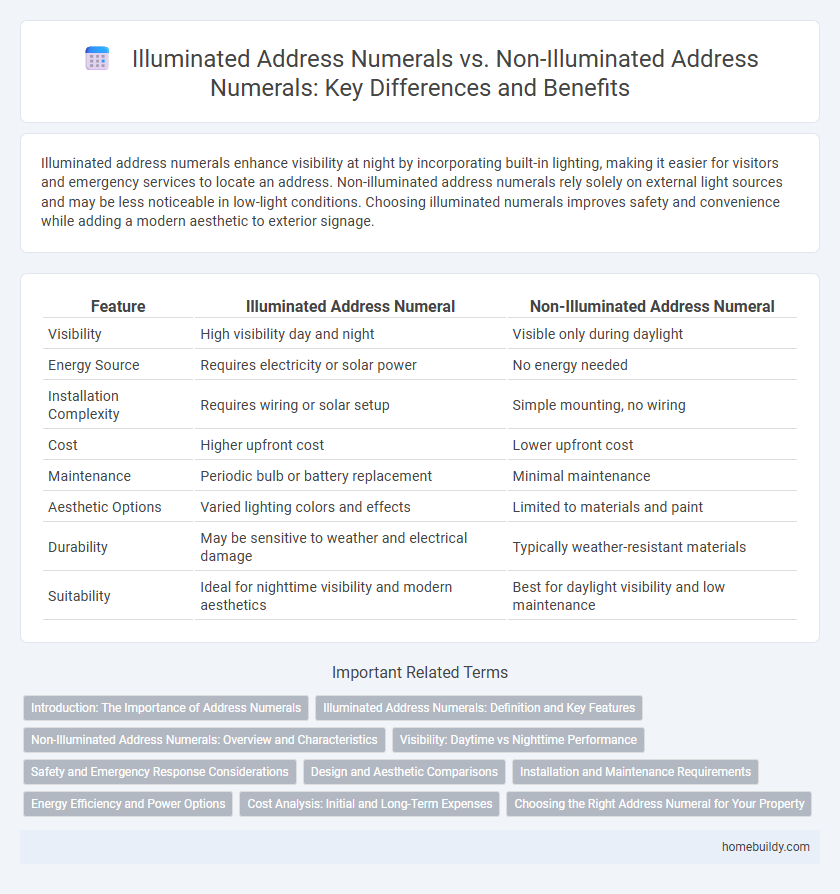Illuminated address numerals enhance visibility at night by incorporating built-in lighting, making it easier for visitors and emergency services to locate an address. Non-illuminated address numerals rely solely on external light sources and may be less noticeable in low-light conditions. Choosing illuminated numerals improves safety and convenience while adding a modern aesthetic to exterior signage.
Table of Comparison
| Feature | Illuminated Address Numeral | Non-Illuminated Address Numeral |
|---|---|---|
| Visibility | High visibility day and night | Visible only during daylight |
| Energy Source | Requires electricity or solar power | No energy needed |
| Installation Complexity | Requires wiring or solar setup | Simple mounting, no wiring |
| Cost | Higher upfront cost | Lower upfront cost |
| Maintenance | Periodic bulb or battery replacement | Minimal maintenance |
| Aesthetic Options | Varied lighting colors and effects | Limited to materials and paint |
| Durability | May be sensitive to weather and electrical damage | Typically weather-resistant materials |
| Suitability | Ideal for nighttime visibility and modern aesthetics | Best for daylight visibility and low maintenance |
Introduction: The Importance of Address Numerals
Address numerals play a crucial role in identifying properties clearly for emergency services, visitors, and delivery personnel. Illuminated address numerals enhance visibility during nighttime and low-light conditions, improving safety and convenience. Non-illuminated numerals rely on external lighting or daylight, which may reduce their effectiveness after dark.
Illuminated Address Numerals: Definition and Key Features
Illuminated address numerals are numbers designed with built-in lighting, often using LED technology to ensure clear visibility in low-light conditions. These numerals enhance curb appeal and improve property identification for visitors and emergency services by providing a consistent, bright display. Key features include energy efficiency, weather resistance, and customizable brightness levels, making them practical and stylish for residential and commercial use.
Non-Illuminated Address Numerals: Overview and Characteristics
Non-illuminated address numerals are typically made from durable materials like metal, plastic, or wood and rely solely on natural or external lighting for visibility. These numerals offer a classic, low-maintenance option that does not require electrical power or wiring, making them ideal for cost-effective and straightforward installation. Their visibility can be enhanced by choosing reflective paints or contrasting colors against the mounting surface, ensuring easy identification during daylight and well-lit conditions.
Visibility: Daytime vs Nighttime Performance
Illuminated address numerals provide superior nighttime visibility due to built-in lighting, ensuring clear identification in low-light conditions. Non-illuminated numerals rely solely on color contrast and reflective materials for daytime readability but can become difficult to discern after dark. The illumination technology, such as LED or solar-powered lights, significantly enhances address recognition during nighttime, improving safety and accessibility.
Safety and Emergency Response Considerations
Illuminated address numerals significantly enhance visibility for emergency responders during nighttime or low-light conditions, enabling faster location identification compared to non-illuminated numerals. Enhanced visibility reduces response times in critical situations, potentially saving lives and minimizing property damage. Non-illuminated address numerals can be difficult to see from a distance or in adverse weather, posing risks to timely emergency interventions.
Design and Aesthetic Comparisons
Illuminated address numerals enhance exterior design by providing clear visibility and a modern aesthetic, especially during nighttime, creating a focal point that contributes to curb appeal. Non-illuminated address numerals offer a traditional and versatile look, available in various materials and finishes, allowing seamless integration with diverse architectural styles. The choice between illuminated and non-illuminated numerals significantly impacts the overall visual impression and functionality of a building's facade.
Installation and Maintenance Requirements
Illuminated address numerals require electrical wiring and a power source, making installation more complex compared to non-illuminated numerals that typically use simple mounting methods. Maintenance of illuminated numerals involves periodic bulb or LED replacements and inspections of electrical connections to ensure consistent visibility. Non-illuminated numerals demand minimal upkeep, generally limited to cleaning and occasional repainting or replacement due to weathering.
Energy Efficiency and Power Options
Illuminated address numerals typically consume more energy due to built-in lighting, but advances in LED technology have significantly enhanced their power efficiency, making them viable for cost-effective, low-energy usage. Non-illuminated address numerals require no electricity, relying solely on visibility through design and placement, which eliminates ongoing energy costs. Solar-powered illuminated numerals offer a sustainable power option by harnessing renewable energy, combining visibility with energy efficiency without increasing electricity bills.
Cost Analysis: Initial and Long-Term Expenses
Illuminated address numerals typically involve higher initial costs due to built-in lighting components and electrical installation requirements, ranging from $50 to $150 per unit compared to $10 to $30 for standard non-illuminated options. Long-term expenses for illuminated numerals include electricity usage, estimated at 1 to 5 watts per hour, and potential maintenance or bulb replacements, potentially increasing annual costs by 10% to 20%. Non-illuminated numerals require minimal maintenance and no ongoing energy expenses, making them more cost-effective over time despite lower upfront investment.
Choosing the Right Address Numeral for Your Property
Illuminated address numerals enhance property visibility during nighttime and poor lighting conditions, improving safety and ease of identification for visitors and emergency services. Non-illuminated numerals are cost-effective, require no electrical connection, and suit properties in well-lit neighborhoods or those aiming for a minimalist aesthetic. Selecting the appropriate address numeral depends on factors like local lighting, budget constraints, desired visibility, and overall architectural style.
Illuminated address numeral vs non-illuminated address numeral Infographic

 homebuildy.com
homebuildy.com